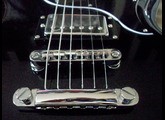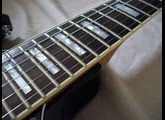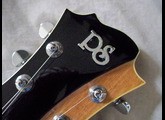« One of the best Rock (classic/hard) guitars I've played »
Published on 10/15/21 at 14:39
Best value:
Correct
Audience:
Anyone
There’s a reason why guitarist collect guitars, besides the novelty of doing so. Each has its own characteristics and each a unique tool to express one’s musical abilities. It’s not only the feel and look (which can affect a person’s mindset), but definitely the sound generated through the pickups and its relationship to the electronics and tone wood. I bring this up, since I have some very high-end guitars that are exceptional for heavy rock and metal, but they don’t sound right when it comes to other forms of music, although ‘acceptable.’
Besides more modern rock/metal, I also like to compose with a more classic rock feel, but I never cared for the guitars I have, although pricey, in how they respond with old Marshalls, a Fender or a Vox, for example. That has changed with the La Flaca by Pure Salem Guitars, a company that focuses on a more classic rock vibe and designs.
The demo below does include some different amps and cabinets, all from a more classic rock era (as opposed to MESA, Diezel, etc.), and I couldn’t be happier. The sound of the La Flaca is very clear, but with a slight growl (only heard with dirt, remaining pristine with cleans). It lacks a ‘thick’ blustery sound, for those who like to ‘chug,’ thus making it more ‘medium’ in depth and fatness.
This stop-tailpiece guitar has three pickup selections. The humbucker (custom-wound Mendiola) has a nice bite, whereas the single-coil neck (also custom-wound) may be subdued (as neck pickups are concerned), but remains clear without any of the excessive bass or flub/mud. In fact, this is my biggest gripe with neck pickups – they have too much bass response, making it too dark for most gear in my studio. Also, when playing lead with a decent amount of gain, there is no hum with the neck pickup, which is a bonus.
When playing clean, there are noticeable differences among bridge, bridge + neck or neck only; and yet, there is a complimentary and somewhat subtle progression among the three selections. In other words, shifting from bridge to neck (or bridge + neck to the other choices) are not dramatic – you don’t suddenly go from the crispness of the bridge to something that has too much midrange or bass in the neck or when combined. Rather, there is smooth transition of tones.
The quality, fit and finish are all very good for the price, coming in at $930 USD, making it a midrange guitar that is decently affordable for most players. There are no flaws in the quality of the guitar, including no sharp fret edges. Moreover, for the price, I find it superior to other guitars I have purchased in the same price-range or slightly higher. (As a side note, I like the bridge very much, as the saddles are smooth and comfortable for resting the palm’s edge, which is not the case with all stop-tailpiece bridges.) The neck is very comfortable, which I’ll elaborate on below, but it’s the overall vibe and sound that captivates me (and I always wanted an SG style guitar, with that itch finally scratched).
I do cover the features of this guitar in the demo, but here is a summary. The mahogany body has a German carve with cream binding, both of which give it flare, and the carve likely reduces the weight somewhat (La Flaca is neither heavy nor light… very middle-ground). The neck also is Mahogany, with dual truss rods, binding, block inlays, medium jumbo frets (nickel, I presume), a rosewood fretboard and Grover locking tuners. The guitar has a 24-¾ scale length, 42.75 mm nut width, 12-inch radius and 2-1/16 string spacing. The neck has a Modern C-shape, which means it’s not a baseball bat, but not thin like most ‘metal’ guitars – again, very middle-ground for most players. The back of the neck is fantastic, super smooth with a light satin finish. The electronics are quiet, while boasting vintage-style cloth wiring.
I have no opinion on other Pure Salem guitars, not having tried them, but if you’re in the market for a rock guitar that can handle classic rock and vintage amps (and that includes a 5150), the La Flaca should be a consideration. It plays well (strings are nice and slinky for string bending), sounds great and the body’s shape makes it ideal to riff out some Black Sabbath in style.
Besides more modern rock/metal, I also like to compose with a more classic rock feel, but I never cared for the guitars I have, although pricey, in how they respond with old Marshalls, a Fender or a Vox, for example. That has changed with the La Flaca by Pure Salem Guitars, a company that focuses on a more classic rock vibe and designs.
The demo below does include some different amps and cabinets, all from a more classic rock era (as opposed to MESA, Diezel, etc.), and I couldn’t be happier. The sound of the La Flaca is very clear, but with a slight growl (only heard with dirt, remaining pristine with cleans). It lacks a ‘thick’ blustery sound, for those who like to ‘chug,’ thus making it more ‘medium’ in depth and fatness.
This stop-tailpiece guitar has three pickup selections. The humbucker (custom-wound Mendiola) has a nice bite, whereas the single-coil neck (also custom-wound) may be subdued (as neck pickups are concerned), but remains clear without any of the excessive bass or flub/mud. In fact, this is my biggest gripe with neck pickups – they have too much bass response, making it too dark for most gear in my studio. Also, when playing lead with a decent amount of gain, there is no hum with the neck pickup, which is a bonus.
When playing clean, there are noticeable differences among bridge, bridge + neck or neck only; and yet, there is a complimentary and somewhat subtle progression among the three selections. In other words, shifting from bridge to neck (or bridge + neck to the other choices) are not dramatic – you don’t suddenly go from the crispness of the bridge to something that has too much midrange or bass in the neck or when combined. Rather, there is smooth transition of tones.
The quality, fit and finish are all very good for the price, coming in at $930 USD, making it a midrange guitar that is decently affordable for most players. There are no flaws in the quality of the guitar, including no sharp fret edges. Moreover, for the price, I find it superior to other guitars I have purchased in the same price-range or slightly higher. (As a side note, I like the bridge very much, as the saddles are smooth and comfortable for resting the palm’s edge, which is not the case with all stop-tailpiece bridges.) The neck is very comfortable, which I’ll elaborate on below, but it’s the overall vibe and sound that captivates me (and I always wanted an SG style guitar, with that itch finally scratched).
I do cover the features of this guitar in the demo, but here is a summary. The mahogany body has a German carve with cream binding, both of which give it flare, and the carve likely reduces the weight somewhat (La Flaca is neither heavy nor light… very middle-ground). The neck also is Mahogany, with dual truss rods, binding, block inlays, medium jumbo frets (nickel, I presume), a rosewood fretboard and Grover locking tuners. The guitar has a 24-¾ scale length, 42.75 mm nut width, 12-inch radius and 2-1/16 string spacing. The neck has a Modern C-shape, which means it’s not a baseball bat, but not thin like most ‘metal’ guitars – again, very middle-ground for most players. The back of the neck is fantastic, super smooth with a light satin finish. The electronics are quiet, while boasting vintage-style cloth wiring.
I have no opinion on other Pure Salem guitars, not having tried them, but if you’re in the market for a rock guitar that can handle classic rock and vintage amps (and that includes a 5150), the La Flaca should be a consideration. It plays well (strings are nice and slinky for string bending), sounds great and the body’s shape makes it ideal to riff out some Black Sabbath in style.




